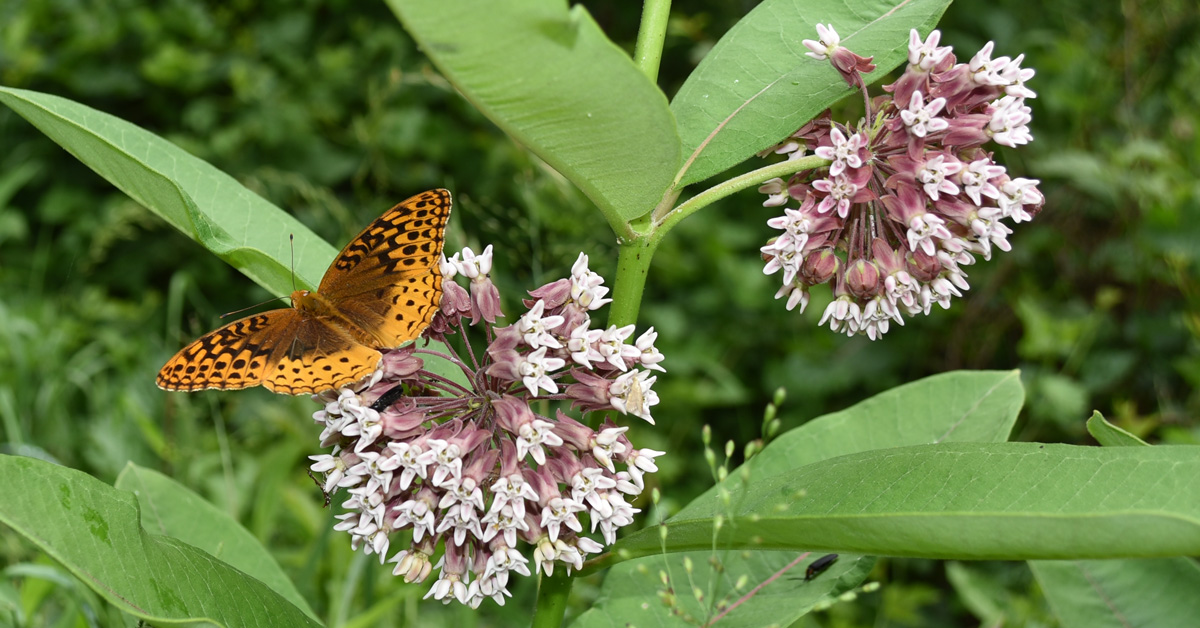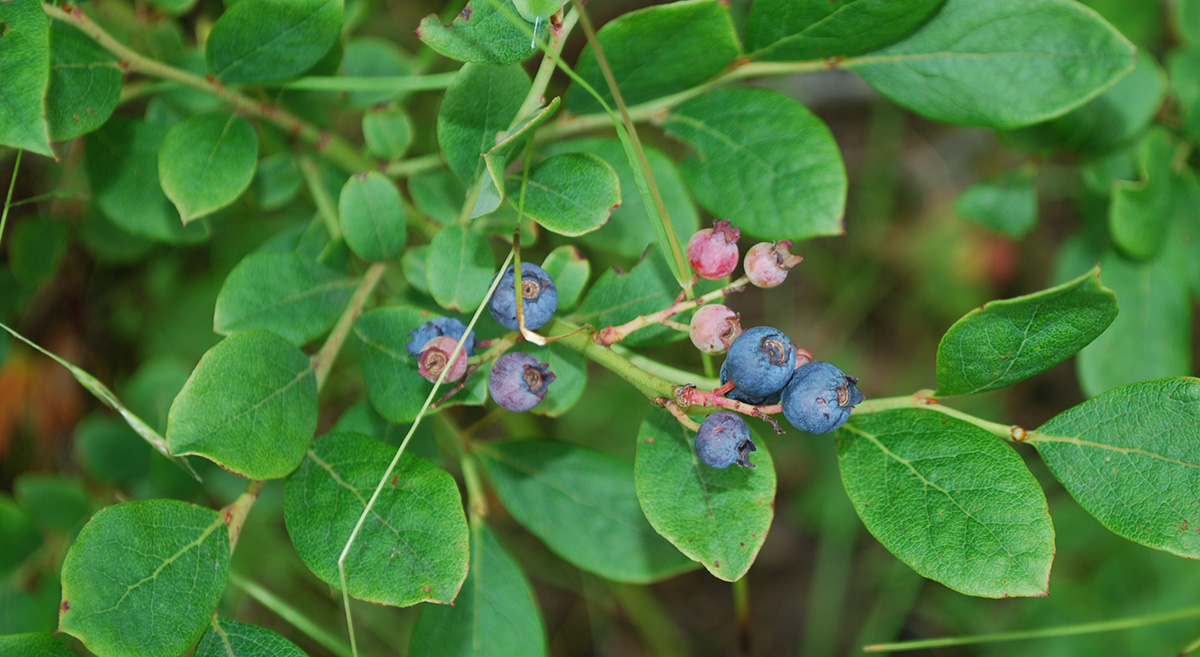
A common sight: milkweed with a butterfly visiting.
By Bruce Ingram
Photos by Bruce Ingram
One aspect hunters, birdwatchers, wildlife watchers, and nature lovers of all persuasions have in common is that the creatures they feel passion for benefit from more hard (acorns) and soft (berries) mast, or food sources, in the woods, fields, and suburban backyards of Virginia. And a way to accomplish more food for wildlife is to plant a pollinator plot in your backyard or rural property.
Eagle Rock’s Trevor Saville, operator of T. Saville Forestry, explains how to start a pollinator plot.
“Find a spot that receives full sun, is well-drained, and that is safe for pollinators,” he says. “Also, a plot should be roughly equidistant from water and other food sources and nighttime sanctuaries. Many pollinators don’t fly very far every day.”
Interestingly, Saville says that though he recommends a soil test before planting, the loam doesn’t have to be overly rich as many wildflowers flourish in poor or even rocky soil. But he does emphasize the removal of invasive plants and grasses before planting.
Bob Glennon, a DWR senior private lands biologist, believes a key in creating a successful pollinator plot is to establish flora native to that particular area of the Old Dominion. In his region, the southeastern part of Tidewater, the biologist recommends the following perennials: narrowleaf mountain mint, spotted bee balm, panicle leaf ticktrefoil, sensitive pea, tall coreopsis, red columbine, Ohio spiderwort, oxeye sunflower, and old field aster. Mix seeds in with little bluestem and split beard bluestem. Bluestems provide habitat on which certain species of butterflies lay their eggs, says the biologist.
Stephen Living, DWR’s Habitat Education Coordinator, adds that for smaller backyard plots, using container grown plants may be simpler and more cost-effective. Ensuring that your location and soils are suitable for the plant is still important as well.
Elisabeth Elliott, Natural Resources Conservation Service (NRCS) Area I Natural Resource Specialist for the upper Shenandoah Valley, says these are some of her favorite wildflowers for her region: wild bergamot, mountain mint, asters, perplexed ticktrefoil, butterfly weed, and dense blazing star.

Wild bergemot
Private lands biologist Tiffany Beachy covers 11 counties sandwiched between the upper Shenandoah Valley and Southwest Virginia. For color and practicality, she favors these varieties: black-eyed Susan, partridge pea (annual), bee balm/wild bergamot (various kinds), lanceleaf coreopsis and purple coneflower. The latter wildflower is native to North America and has become naturalized in Virginia. The purple coneflower is an excellent plant for drawing pollinators.
In Southwest Virginia, good choices include black-eyed Susan, partridge pea, wild bergamot, fire pink, lanceleaf coreopsis, golden ragwort, and wild columbine. For Northeast Virginia and upper Tidewater, consider wild columbine, wild geranium, and joe-pye weed.

Wild columbine adds a dash of color to any pollinator plot.
For the Southern Piedmont and Southside part of the state, among the many possibilities are black-eyed Susan, wild geranium, green and gold, and basil beebalm. Living adds grass-leaf blazing star and calico aster to that list as both of these have fairly wide distribution across both regions.
DWR Wildlife Biologist Marc Puckett says wildflowers aren’t the only flora that can be planted. “Folks seem to always overlook native shrubs when they do projects for pollinators,” he says. “The same folks who want only native plants in their wildflower beds often landscape with things like nandina (Japanese bamboo), butterfly bush, and burning bush—all potentially invasive and non-native species sold in box stores across the U.S.”
So Puckett offers one species of herbaceous annual and four shrubs.
“My flower species is partridge pea—the tall growing version Chamaecrista fasciculate,” he says. “Though an annual, it is highly reliable and will persist in a planting for several years. It also responds to prescribed fire or light disking well. It flowers from late July until after the first few frosts and will have some seedpods fully set while still flowering. It is a great plant for hosting many insects, which makes it great for foraging young birds like quail, turkey, and grouse.” In addition, partridge pea only needs to be spread at 2 lbs. per acre (1 lb. per acre if mixed with other seeds). It is best planted during late winter to early spring, best before the end of March if possible.

Wild blueberries have the virtue of attracting pollinators and being tasty to eat.
“My shrubs are wild plum or American plum—a very early flowering shrub that helps provide for bees when food sources are scarce. Redbud is another; have you ever watched native bumble bees work redbud? The third is blueberry—wow—bees galore, and then we can eat the fruit. And the last for me is elderberry for more moist or streamside sites. These shrubs cover flowering from mid-March until early to mid-June.”
Glennon has this technical advice for the actual planting:
- Sow seed before the average last date of frost locally: April 1 in the Coastal Plain region, April 15 in the Piedmont, and May 1 in the Mountains and Shenandoah Valley regions. Seed sown after those dates may not germinate until the year after it is sown, and after it has been exposed to cool (40 degrees F), moist conditions in the soil.
- Non-native plants will out-compete native plants every time. They must be killed before the native plants are seeded. It may take a combination of tillage, herbicide treatment, and smother cropping with warm-season and cool-season annual cover crops to kill the non-native plants. Stands established in areas that once had non-native plants may require annual treatment of herbicides for many years to control the competition.
- If seed is broadcast, it should be on a seedbed that has been thoroughly tilled and packed firm. The seedbed must be packed firm again after the seed is sown. If it is broadcast with a seeder that does not have a small seed box and a chaffy seed box, the seed must be bulked up with an inert carrier, such as pelletized lime. A ratio of 20: 1 of carrier to seed by weight is required to get chaffy seed to pass through the seeder.
- If the seed is drilled with a native seed drill, it should be sown no deeper than ¼ inch and the packing wheels on the drill adjusted to firm the drill rows firmly.
- All seeders must be calibrated to deliver the correct amount of pure live seed recommended. Seeds of native plants varies greatly in germination and purity, and the seeding rates of each species must be calculated carefully.
- Seeding rates are based on the number of pure live seeds per square foot: 30 pure live seeds per square foot for drilled seedings, and 45 pure live seeds per square foot for broadcast seedings. Those rates usually are the equivalent of 4 to 6 pounds of pure live seed per acre drilled, and 6 to 9 pounds of pure live seed per acre broadcast.
If you need help starting a backyard pollinator plot or one on a rural property, the websites and organizations below can provide assistance, and some even offer volunteers:
The Plant Virginia Natives Initiative has regional, downloadable PDFs listing native plantings for specific regions of the state.
Virginia Cooperative Extension Master Gardener: Offers more than 5,000 volunteers across state who will help local people.
Virginia Native Plant Society has chapters across the state.
For organic farmers and others interested in pollinators, check out these NRCS websites: https://www.nrcs.usda.gov/wps/portal/nrcs/detail/programs/financial/eqip/?cid=stelprdb1265870.
The Virginia Department of Forestry has a page that covers types of tree and shrub seedlings and how to plant them.
The Xerces Society for Invertebrate Conservation supplies a great deal of information about the conservation of invertebrates and their habitats.

